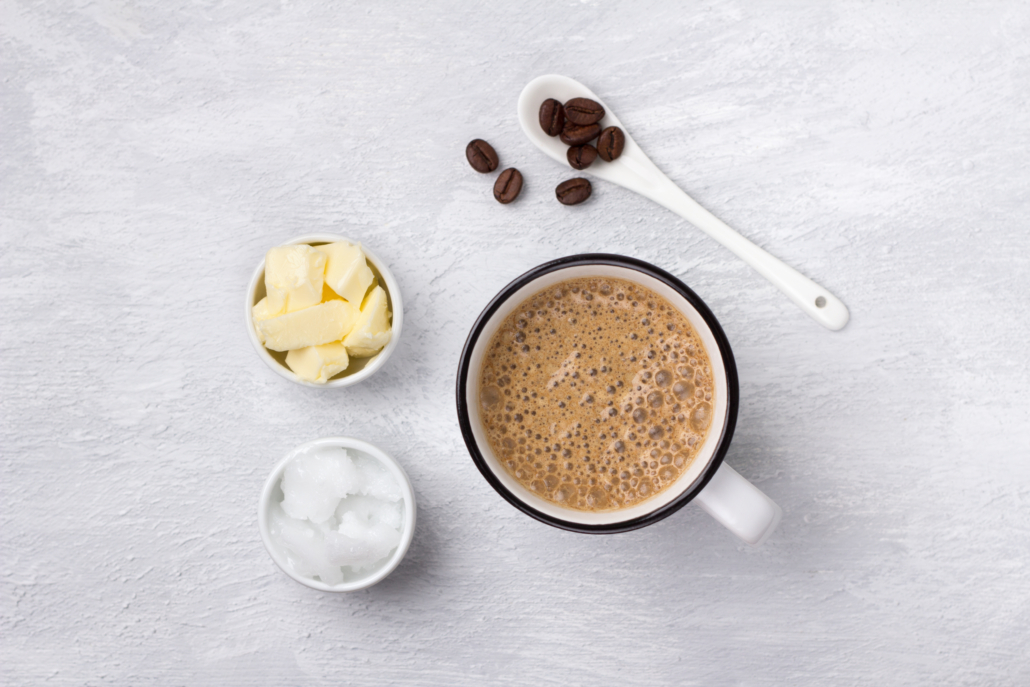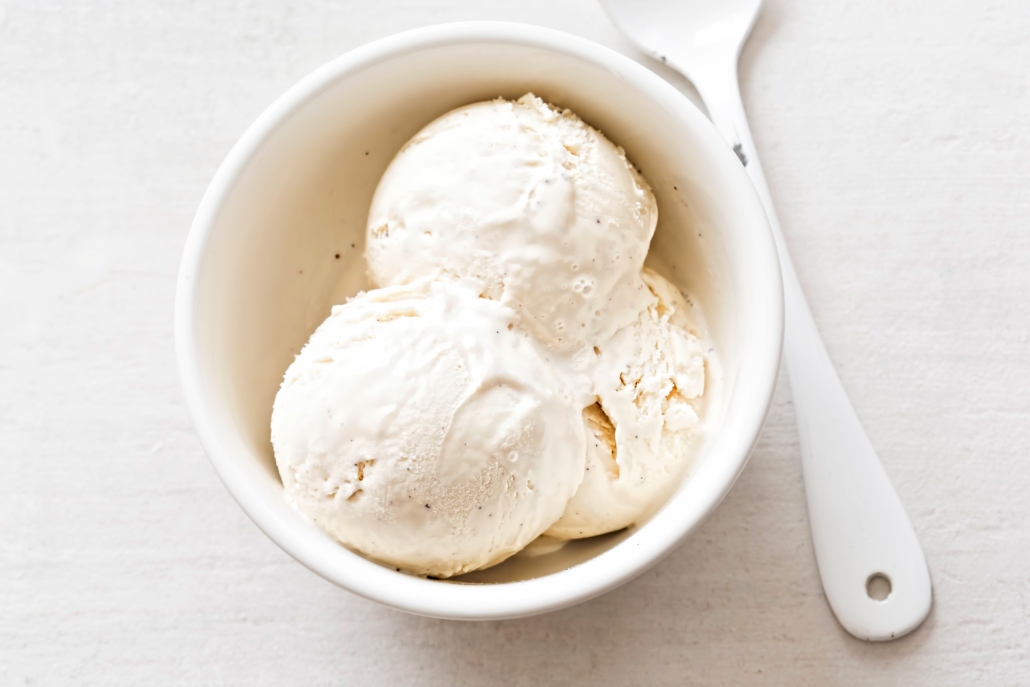We include products in articles we think are useful for our readers. If you buy products or services through links on our website, we may earn a small commission.
The Best High Fat Keto Foods and Others to Avoid
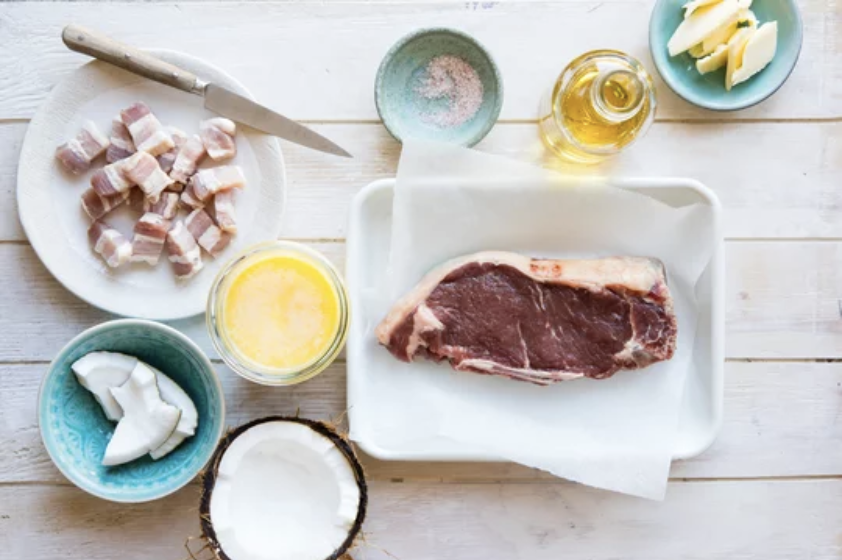
The ketogenic diet is a high-fat low-carb way of eating centered around high fat keto foods.
A well-formulated keto diet includes healthy fats, fatty meats from land and sea, and full-fat dairy while eliminating all foods made with industrial seed and vegetable oils.
This way of eating aligns with our biological inheritance. As researcher Amber O’Hearn shows us, humans are ‘lipivores’, or primarily fat eaters. Over eons of evolution, our cavemen ancestors ate a diet of mostly fatty meat. Now our modern bodies still bare this genetic inheritance in our unique ability to digest, store, and utilize fat for energy.
Dr. Kiltz makes a high-fat low-card diet one of his three pillars of health and wellness.
Let’s explore a full list of the best high fat keto foods.
Table of Contents
Why High Fat Keto Foods?
Eating high fat foods and restricting carbs fuels your body with the macronutrient we need the most while giving us the protein we need and eliminating non-essential carbs.
The standard keto macro percentages are:
- 75-80% calories from fat
- 10-20% calories from protein
- 0-5% calories from carbs
If your daily caloric intake is 2,000, a standard keto macronutrient breakdown looks like:
- 150-178 grams of fat
- 75-100 grams of protein,
- 0-25 grams of carbs
This works out to 2.3 grams of fat for every 1 gram of protein.
For most people coming from a high-carb standard American diet based on processed grains and vegetable oils, consuming enough fat from whole foods sources can be a challenge at first.
That’s why keto fats top our list of high fat keto foods. A couple of tablespoons of each of these fats added to a meal can boost your fat intake to an optimal level.
Keto Fats
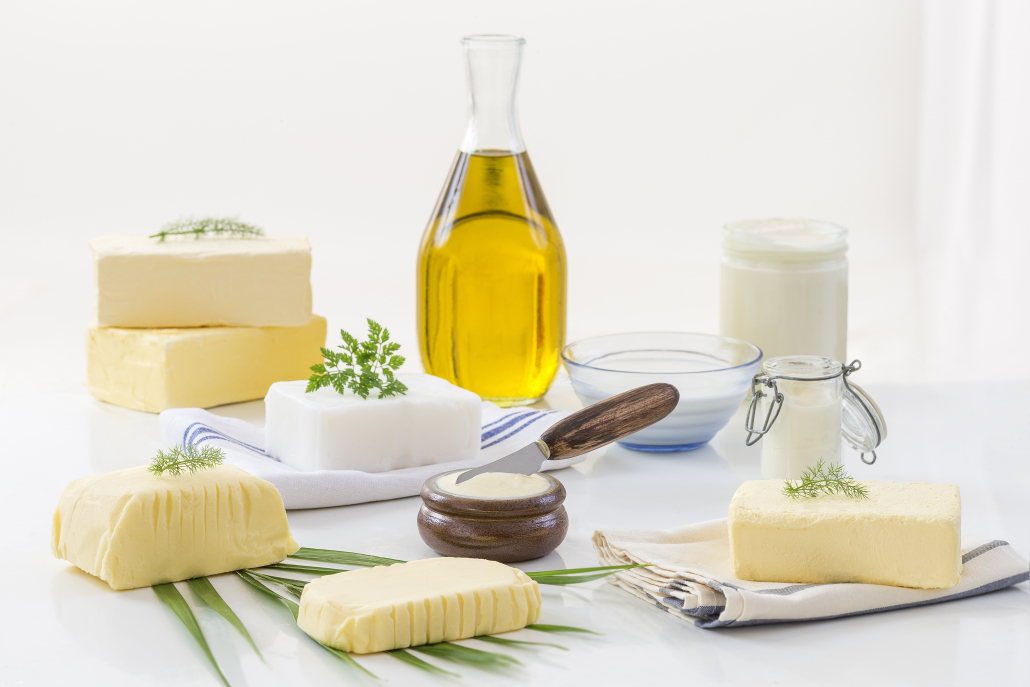
The key to making keto enjoyable and sustainable is almost always eating more fat.
These healthy keto fats are derived from whole foods sources, loaded with saturated and monounsaturated fats, and low in inflammatory PUFAs.
| TYPE | SFA% | PUFA % | CARBS | TOTAL FAT | NOTES |
| Beef Tallow | 49.8 | 3.1 | 0g | 12.8 | Mild beef flavor Can be heated |
| Lard | 41 | 12 | 0g | 13g | Mild flavor Can be heated |
| Butter | 50 | 3.4 | 0g | 12g | Mildly Sweet Lower Heat |
| Ghee | 48 | 5 | 0g | 9g | Mild nutty flavor Can be heated |
| Duck Fat (Tallow) | 25 | 13 | 0g | 13g | Rich Duck flavor Can be heated |
| Heavy Cream | 62 | 4 | .5g | 5.4 | Sweet and rich |
| Coconut Oil | 92 | 1.9 | 0 | 13.6 | Mild coconut/nutty flavor Can be heated |
| Olive Oil | 14 | 11 | 0 | 14 | Savory and a bit spicey |
Tallow
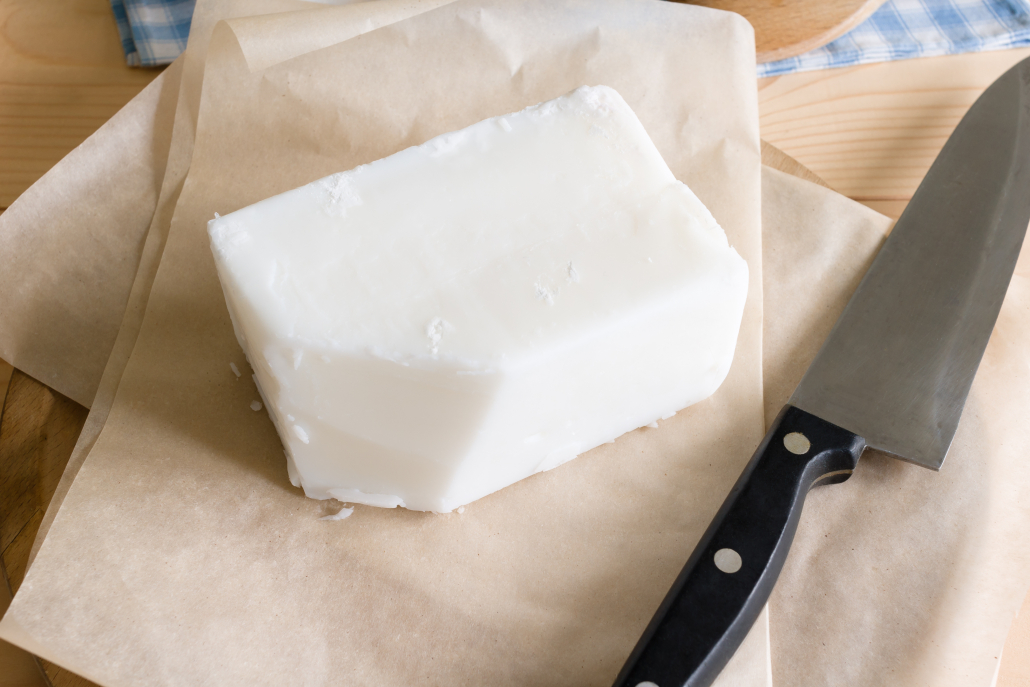
Tallow is rendered animal fat, and beef tallow is the most common and accessible type of tallow.
In addition to healthy saturated fats, grass-fed tallow provides fat-soluble vitamins
vitamin E, A, D, K2, B1, CLA (conjugated linoleic acid), and omega 3’s.
Butter
Butter provides many beneficial nutrients, such as conjugated linoleic acid (CLA) and butyrate.
Research shows that eating high-fat dairy products like butter can reduce your risk of obesity, diabetes, heart disease, and various cancers. Butter is also linked to improved sleep, immune function, and fertility [2][3][4][5][6][7][8].
Ghee
Ghee is produced by using heat to remove milk solids and water from butter. This gives it a nuttier flavor and higher smoke point when heated. Ghee provides K2, A, and E.
Ghee is a good choice for people with dairy allergies because it is lactose-and casein-free.
Coconut Oil
Coconut oil is a popular keto fat because of its medium chain triglycerides (MCTs) that make up 54% of its fatty acid content. MCTs are directly metabolized into ketones. Getting into ketosis quickly can help reduce some of the uncomfortable side effects when making the change to keto [23].
Lard
Lard is fat rendered from pigs. Most lard comes from a pig’s back fat, or ‘leaf fat.’
The lard from pasture-raised pigs contains vitamin D, while feed-lot lardis lower in vitamin D and higher in unhealthy PUFAs. Unlike ruminants, pigs do not convert unhealthy fats into healthy fats. Pigs, like humans, are what they eat [2][3].
Olive Oil
At 14% SFA, olive oil is the least saturated of the acceptable keto fats. Most of its fat (73%) is monounsaturated oleic fatty acid. Though olive oil is a part of the Mediterranean keto diet, and an important source of fat for vegan and vegetarian keto dieters, we recommend sticking with the animal fats we are most physiologically adapted to thrive on.
Studies show that oleic acid can reduce inflammation and reduce the risk of some types of cancer [4][5]..
You might be asking, isn’t olive oil a vegetable oil? Technically it’s a fruit oil like coconut. Olive oil can be rendered with far less processing than vegetable and seed oils. Olive oil is also metabolized differently in the body.
In one study on mice fed a high fat diet, one group was fed olive oil and the other vegetable oil. The vegetable oil group developed insulin resistance, while the other group didn’t, and this occurred independently of carb intake [3].
High Fat Keto Meats
High fat keto meats are the most important component of a well-formulated keto diet. Put them at the top of your keto shopping list.
There are numerous benefits of eating fatty meat both for your health, and when regeneratively raised, for the environment.
It’s worth noting that modern science has debunked the false links between fresh meat, cancer, heart disease, diabetes, and stroke [17][14] [1] [2] [3] [4] [5].
Here’s a rundown of the top fatty meats from beef, pork, lamb, organ meats, and poultry.
Nutrition Based on 4 oz (112g) serving
| Ranking | Keto Meat | Calories | Fat | Protein | Carbs | %Calories from fat | % Calories from protein | |
| #1 | Ribeye steak | 310 | 25 | 20 | 0 | 73% | 26% | |
| #2 | Bison Ribeye | 210 | 13 | 23 | 0 | 55% | 45% | |
| #3 | Pork Belly | 588 | 60 | 10.4 | 0 | 92% | 7% | |
| #4 | Rack of lamb | 330 | 22 | 30 | 0 | 63% | 37% | |
| #5 | Sweetbreads | 356 | 33.6 | 14.6 | 0 | 82% | 18% | |
| #6 | Chicken Wings | 320 | 22 | 30.4 | 0 | 62% | 38% |
Steak and Ruminant Meats
Fatty cuts of ruminant animals like steak, bison, elk, and lamb are the stars of keto and carnivore diet meal plans.
These animals are called ruminants because they have a rumen–the first of four stomachs. The rumen breaks down fiber from plants and grass and turns it into healthy saturated and monounsaturated fatty acids.
Pigs, fish, and poultry don’t have a rumen and cannot process the foods they eat into fatty acids in the same way. Like humans, they are essentially what they eat.
Ruminant meats make the best high fat keto foods, thanks in part to a process of ruminant digestive that ferments plants into Conjugated Linoleic Acid (CLA).
Since humans cannot manufacture CLA within our bodies, we need to get it from our high fat keto foods.
The CLA in high fat keto foods offers numerous benefits, including [1][2][3][4][6]:
- Reduced excess body fat, increased lean muscle mass
- Reducing atherosclerosis
- Improved immune function
- Prevention and treatment of diabetes
- Proper formation and mineral density
Bioavailable Nutrients
High fat ruminant meats also provide an abundance of essential B vitamins, zinc, selenium, and numerous nutrients found only in meat, like carnitine and carnosine.
The zinc found in beef and ruminants is 400% more bioavailable than zinc from grains [1]
Ribeye: King of Keto Meats
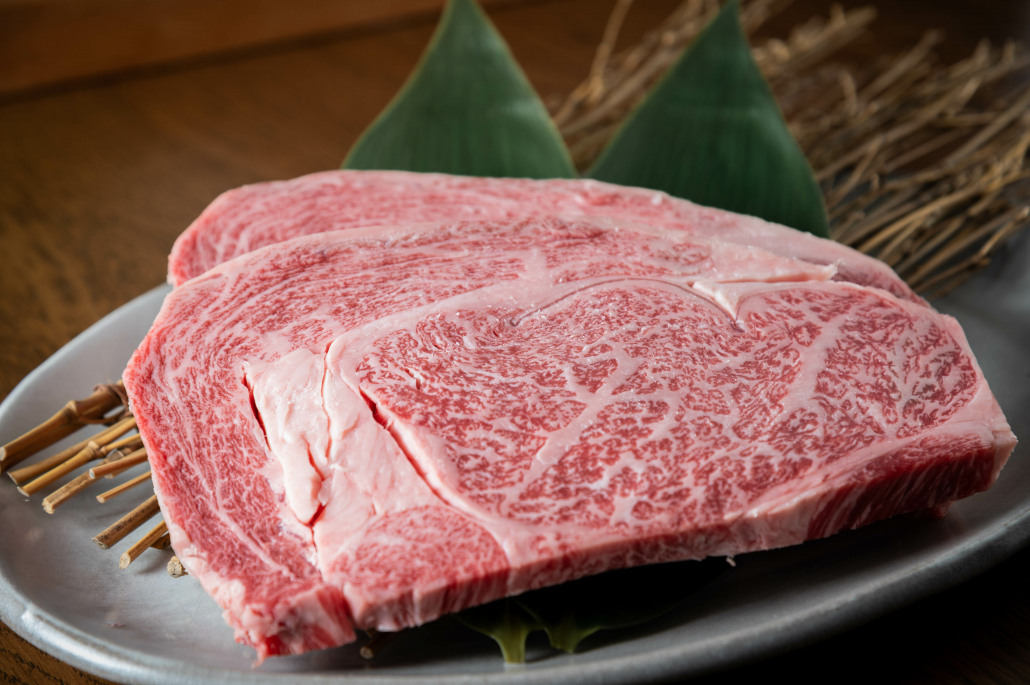
Of all the high fat keto foods, one of the most delicious and nutritious is ribeye steak. It’s tender, juicy, and one of the most nutrient dense foods on earth.
Ribeye is so nutritionally-replete that there is a type of carnivore diet, the lion diet, that calls for only ribeye, salt, and water.
Here’s a deeper look at the nutritional powerhouse that is ribeye steak:
| NUTRIENT | 227G (8 OZ) | |
| Calories | 560 cal | |
| Fat | 34g | |
| Saturated Fat | 12g | |
| Monounsaturated Fat | 12g | |
| Carbs | 0 | |
| Protein | 65g | |
| Vitamins | ||
| B1 (Thiamin) | 25% | |
| B2 (Riboflavin) | 23% | |
| B3 (Niacin) | 119% | |
| B5 (Pantothenic Acid) | 30% | |
| B6 | 100% | |
| B9 (Folate) | 7% | |
| B12 | 142% | |
| Vitamin D | 70% | |
| Vitamin E | 7% | |
| Choline | 70% | |
| Minerals | ||
| Magnesium | 12% | |
| Potassium | 14% | |
| Iron | 31% | |
| Copper | 33% | |
| Phosphorus | 42% | |
| Selenium | 131% | |
| Zinc | 111% |
High Fat Keto Steak
In addition to ribeye, there are many other fatty cuts of steak on keto. Here’s a rundown of other worthy high fat cuts of steak.
| High-Fat Low-Carb Steak | Calories | Fat | Protein | Carbs | % Calories from fat | % Calories from protein |
| Boneless short ribs | 440 | 41 | 16 | 0 | 84 | 15 |
| Tri-tip roast | 340 | 29 | 18 | 0 | 77 | 21 |
| Beef Back Ribs | 310 | 26 | 19 | 0 | 75 | 25 |
| Porterhouse | 280 | 22 | 21 | 0 | 70 | 30 |
| Top Sirloin | 240 | 16 | 22 | 0 | 60 | 37 |
| 80/20 Ground Beef | 307 | 19.6 | 30.5 | 0 | 59 | 41 |
Pork
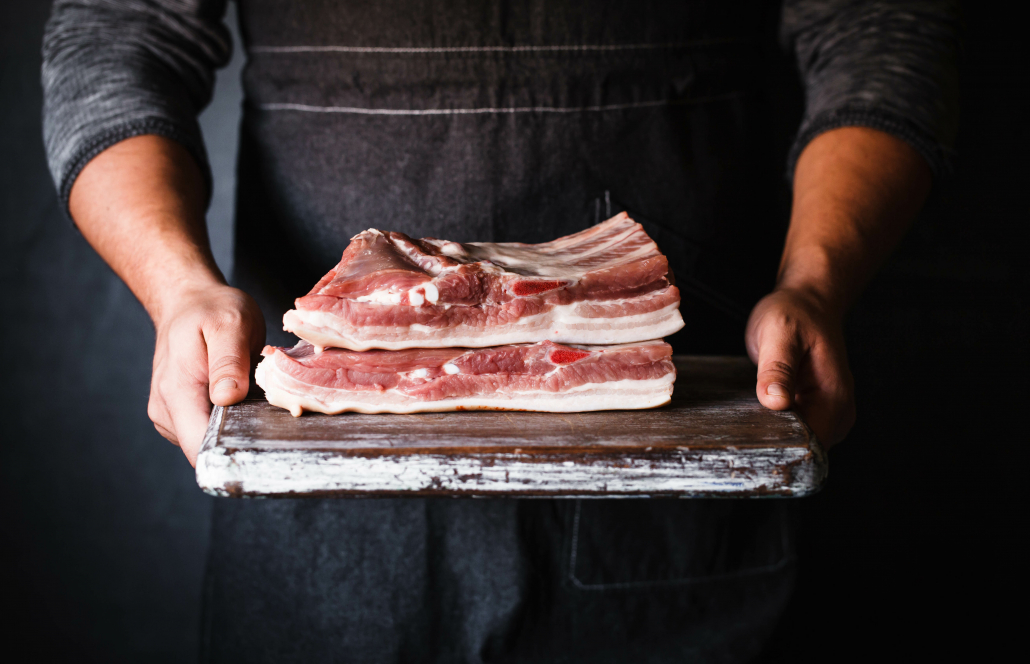
Bacon is the most popular high fat keto food when it comes to pork. But there are numerous other high fat cuts like ribs and fresh pork belly.
Though less dense in micronutrients than beef, pork provides an abundance of essential b vitamins and rarer nutrients like choline and selenium.
Pork raised in pastures under the sunshine is a great source of vitamin D.
Here’s a list of the seven fattiest cuts of pork on keto.
Nutritional information per 4 oz.
| Pork Cut | Calories | Fat | Protein | % Calories Fat | % Calories Protein | |
| #1 | Pork Belly | 588 | 60 | 10.4 | 92 | 7 |
| #2 | Baby back ribs | 315 | 27 | 18 | 77 | 23 |
| #3 | Pork Hocks | 285 | 24 | 17 | 76 | 24 |
| #4 | Shoulder | 285 | 23 | 19 | 73 | 27 |
| #5 | Bacon | 600 | 47.2 | 41.9 | 71 | 28 |
| #6 | Butt | 240 | 18 | 19 | 68 | 32 |
| #7 | Leg Ham | 305 | 20 | 30.4 | 59 | 40 |
Lamb
Along with the macro and micronutrients of other ruminant meats, lamb stands out for offering more CLA than any other meat
Lamb also has high levels of glutathione. This antioxidant has been shown to reduce insulin resistance, reduce the risk of autoimmune disease, reduce symptoms of Parkinson’s disease, and protect against oxidative damage in children with autism [2].
Here’s a list of the fattiest cuts of lamb.
Nutrition information per 4 oz.
| Lamb Cut | Calories | Fat | Protein | Carbs | % Calories from Fat | % Calories from protein | |
| #1 | Chop/Rack | 330 | 22 | 30 | 0 | 63 | 37 |
| #2 | Loin Chop | 330 | 22 | 30 | 0 | 63 | 37 |
| #3 | Leg | 292 | 18.7 | 29.3 | 0 | 59 | 41 |
| #4 | Shank | 276 | 14.7 | 32 | 0 | 52 | 48 |
Eggs
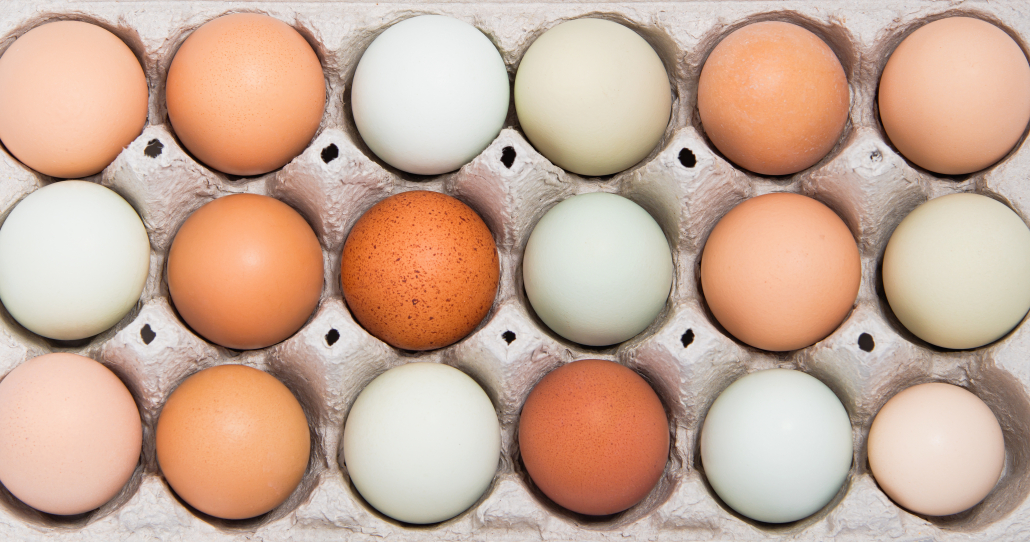
Eggs are one of the most nutritionally complete high fat keto foods.
Hard boiled eggs make a great keto snack.
Eggs provide B vitamins, choline, and folate, among other essential nutrients. They’re also a great food to add to your fertility diet if trying to get pregnant [10].
Here’s a closer look at the nutrients packed into this inexpensive and portable high fat keto food:
| Nutrients | 100 grams (appx 2 eggs) | %Daily Value |
| Calories | 140 | |
| Fat | 10 | |
| Protein | 12 | |
| Vitamins and Minerals | ||
| Retinol (vitamin A) | 98mcg | 12% |
| Riboflavin | 0.4mg | 33% |
| Vitamin B12 | 0.33mcg | 100% |
| Biotin | 5.2mcg | 17% |
| Folate | 88mcg | 30% |
| Vitamin D | 7.9mcg | 30% |
| Vitamin E | 1.9mg | 30% |
| Pantothenic acid | 1.07mg | 22% |
| Phosphorus | 171mg | 25% |
| Iron | 1.8mg | Men (23%) Women (10%) |
| Selenium | 28mcg | 50% |
| Zinc | 1.0mg | 10% |
| Iodine | 47mcg | 33% |
High Fat Keto Dairy
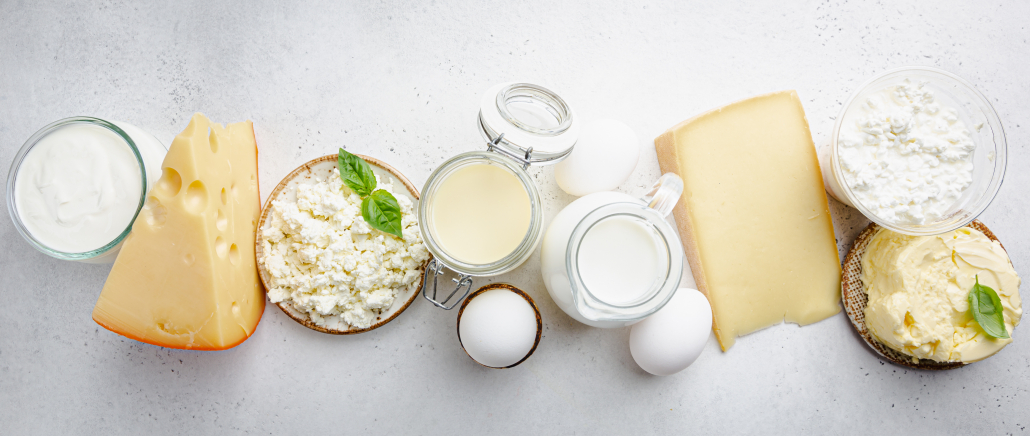
| Nutrients Per 100 grams (3.5 oz) | Cream Cheese | Triple Cream Brie (Saint Andre) | Cheddar | Blue Cheese | Swiss Cheese | Parmesan |
| Fat | 35g | 42g | 33g | 29g | 31g | 28g |
| Carbs | 1g | 0g | 3g | 26 | 1g | 14g |
| Protein | 7g | 10.5g | 23g | 21g | 27g | 28g |
| Fat: Protein Ratio by grams | 5:1 | 4:1 | 1.4:1 | 1.3:1 | 1.1:1 | 1:1 |
High Fat Keto Seafood
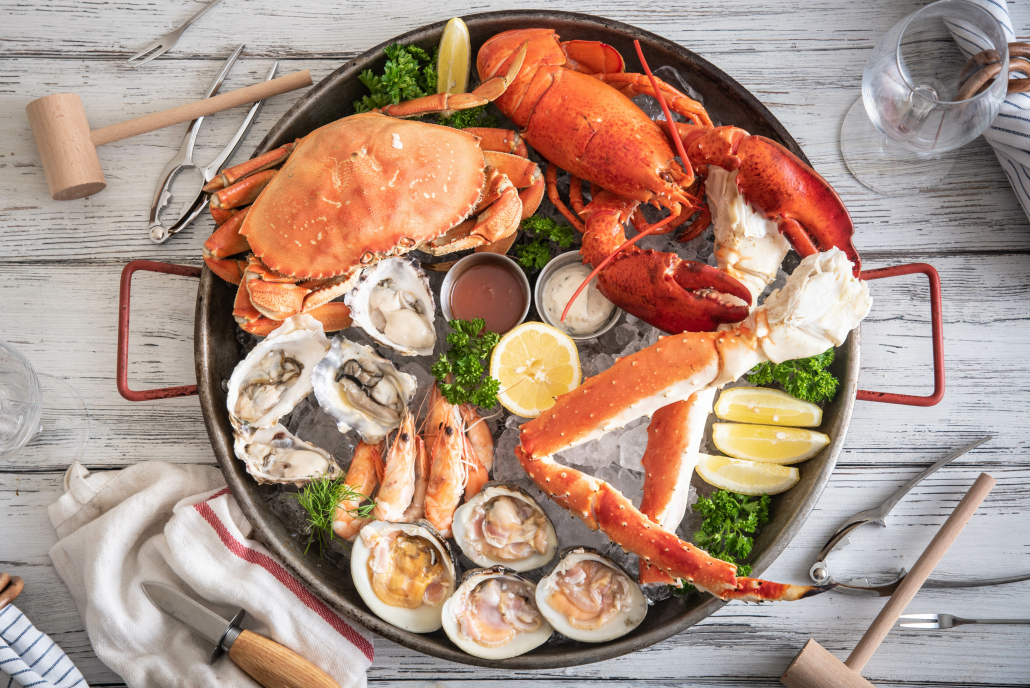
The best keto seafood provide an extensive list of crucial vitamins and minerals, including robust amounts of vitamin B and D, zinc, selenium, copper, and omega-3 fatty acids.
Though most keto seafood are excellent sources of protein, most of them are fairly lean. This means you’ll have to boost the fat of your seafood with whole food fats like tallow, and butter. But that’s no reason not to add them to your everyday keto grocery list.
Fish
| TYPE OF FISH | CALORIES | FAT | PROTEIN | CARBS | % CALORIES FROM FAT | % CALORIES FROM PROTEIN | |
| Atlantic Mackerel | 290 | 20.3 | 27 | 0 | 63 | 37 | |
| Farmed Arctic Char | 208 | 12 | 19 | 0 | 58 | 42 | |
| Anchovies | 256 | 15.9 | 28 | 0 | 56 | 44 | |
| Farmed Salmon | 234 | 14 | 25 | 0 | 56 | 44 | |
| Wild King Salmon | 195 | 13 | 22 | 0 | 54 | 46 | |
| Sardines | 139 | 8 | 19 | 0 | 50 | 50 |
Roe, Crustaceans, and Shellfish
Roe, crustacean, and shellfish are generally nutrient-rich, yet all relatively lean for keto foods. They will need to be fattened up with butter or other keto fats.
| Type of Seafood | Calories | Fat | Protein | Carbs | % Calories from fat | % Calories from protein | % Calories from carbs |
| Salmon Caviar (Roe) | 260 | 14 | 29 | 2.9 | 45 | 52 | 3% |
| Oysters | 58 | 1.9 | 6.5 | 3.1 | 29 | 33 | 28 |
| Mussels | 97 | 2.8 | 13.5 | 4.5 | 26 | 56 | 19 |
| Shrimp | 135 | 2.0 | 25.8 | 1.7 | 18 | 78 | 4 |
| Dungeness Crab | 107 | 2.0 | 22 | 0 | 17 | 82 | 0 |
| Lobster | 116 | 1.8 | 25 | 0 | 14 | 86 | 0 |
| Clams | 82 | 1.1 | 15 | 3 | 12 | 73 | 15 |
| Scallops | 97 | 1.0 | 19 | 3 | 9 | 78 | 12 |
High Fat Keto Poultry
Compared to ruminant meats and pork, poultry is a lean meat that will benefit from additions of butter, ghee, lard, and tallow. The highest fat poultry are cuts with the skin on.
There’s also a variety of poultry that is always encouraged due to it’s incredible abundance of micronutrients: chicken liver and duck liver.
Here is a list of the fattiest poultry for keto:
| Poultry | Calories | Fat | Protein | Carbs | % Fat | % Carbs | |
| #1 | Goose | 340 | 24.9 | 28.5 | 0 | 66 | 34 |
| #2 | Game Hen | 220 | 16 | 19 | 0 | 65 | 35 |
| #3 | Chicken Wings | 320 | 22 | 30.4 | 0 | 62 | 38 |
| #4 | Chicken thigh (skin on) | 275 | 17.6 | 28.3 | 0 | 58 | 41 |
| #5 | Duck | 228 | 13.9 | 26.3 | 0 | 55 | 46 |
| #6 | Chicken Leg (skin on) | 275 | 15.2 | 29.4 | 0 | 54 | 46 |
High Fat Keto Fruits
Doctor Kiltz does not recommend eating any fruit including avocado with any frequency, but if you absolutely must, consider yourself warned.
High-fat animal products are the best keto foods with zero risk of irritation and allergic side effects from plant toxins and antinutrients.
There are, however, a few high-fat fruits that pass as keto foods. We’ve already touched on two of them–olives and coconuts in the section on fats above. Which leaves us with avocados.
Avocado
In addition to boasting 30 grams of fat in just a single avocado, these fruits are offer an abundance of both macro and micronutrients that many people eating modern Western diets lack. On a ketogenic diet avocados are one of the few low-carb foods high in potassium and vitamin C.
Studies show that avocados can support your heart, maintain healthy blood sugar levels, and help you age gracefully [1][2]
Avocados are a good source of many B vitamins, including folate. Folate plays a key role in the production of red and white blood cells in bone marrow, DNA and RNA, and fetal development [27].
For people practicing vegan or vegetarian keto, avocados can be an important fat staple.
The potassium in avocados is essential for nervous system function and blood pressure regulation and protective against stroke and hypertension [28][29].
A study looking at the effects of avocados on gut health showed that after eating the equivalent of 1 avocado a day for 12 weeks lowered concentrations of fecal bile acid while increasing diversity of healthy gut bacteria [30].
Avocado Allergies
Though much of the research on avocados has sought out their benefits, an emerging body of research has linked avocados to allergic reactions, some of which can be severe. If you have a latex allergy, avocados may be a trigger [3][4].
Remember that plants have numerous defense mechanisms intended to keep them safe from predators, including humans.
If you are practicing keto to remedy digestive issues and food allergies, Dr. Kiltz recommends eliminating nearly all plant foods, including avocados.
Nutrients in a medium Hass avocado
| Nutrients | |
|---|---|
| Calories | 322 |
| Fat | 30 g |
| Protein | 4 g |
| Carbohydrates | 17 g |
| Fiber | 14 g |
| Vitamin C | 22% |
| Vitamin E | 28% |
| Vitamin K | 35% |
| B2 | 20% |
| B3 | 22% |
| B5 | 56% |
| B6 | 30% |
| Folate | 41% |
| Magnesium | 14% |
| Potassium | 21% |
| Copper | 42% |
| Manganese | 12% |
Nuts and Seeds
Though nuts contain lots of fat, some of which is healthy, they can also be high in questionable fats, Omega-6 PUFAs, abrasive fiber, and plant toxins like phytoalexins.
Again, we note that Doctor Kiltz strongly recommends eliminating nuts and seeds from your high-fat low-carb diet to prevent against toxins, gut irritation, and excess fiber.
Omega-3 to Omega 6 Ratio
Modern food systems high in processed vegetable oils lead to an imbalance in Omega-6/Omega-3 fatty acid ratios.
Both of these fatty acids play important roles in the body. Humans evolved on a diet with a ratio of roughly 1:1. Omega-6s tend to be pro-inflammatory, while Omega-3 EFAs such as Alpha-Linoleic acid are anti-inflammatory [13].
In the modern Western diet, it’s estimated that the ratio is now around 15:1. This imbalance can result in chronic inflammation [14][15].
Since the keto diet takes cues from ancestral ways of eating, limiting Omega 6’s and returning to our physiological baseline may be crucial for reducing inflammation.
The chart below shows the Omega-3 and 6 content of various nuts. When eating nuts you are always getting more omega-6s than 3s.
| Nut | Fats (g) | Omega 3 (g) | Omega 6 (g) | Omega 3:6 ratio (closer to 1 the better) | Ratio*1000 |
| Hemp Hearts/Seeds | 62.7 | 11 | 33 | .33 | 333.3 |
| Macadamia nut | 100 | 0.26 | 1.72 | 0.1512 | 151.2 |
| Walnut | 73.7 | 2.51 | 41.3 | 0.0608 | 60.8 |
| Pecans | 78.5 | 1.08 | 22.487 | 0.0480 | 48.0 |
| Pistachio nuts | 54.7 | 0.312 | 16.23 | 0.0192 | 19.2 |
| Hazelnut | 69.9 | 0.1 | 9 | 0.0111 | 11.1 |
| Cashew | 59.568 | 0.08432 | 10.5808 | 0.0080 | 8.0 |
| Pine nuts | 92.3 | 0.15 | 45.37 | 0.0033 | 3.3 |
| Brazil nut | 88.4 | 0.02 | 27.4 | 0.0007 | 0.7 |
| Almonds | 73.4 | 0.01 | 17.5 | 0.0006 | 0.6 |
| Peanuts | 72.5 | 0.01 | 22.9 | 0.0004 | 0.4 |
High Fat Foods to Avoid on Keto
There are two kinds of fats that should be avoided. The most inflammatory fat is trans fatty acids (trans fats) from industrial products including:
- Margarine
- Vegetable shortening
- Processed foods with Ingredients that list Hydrogenated (fully or partially) oils
Another type of fat to reduce or avoid is called polyunsaturated fatty acids (PUFAs). PUFAs generally come from heavily processed, easily oxidized vegetable and seed oils. They have been shown to increase inflammation and cardiovascular disease [4].
Here is a list of the most common PUFA sources to elminate:
- Grapeseed oil: 70.6% PUFA
- Sunflower oil: 68% PUFA
- Flax oil: 66% PUFA
- Safflower oil: 65% PUFA
- Corn oil: 54.6% PUFA
- Walnut oil: 53.9% PUFA
- Cottonseed oil: 52.4% PUFA
- Vegetable oil (soybean oil): 51.4% PUFA
- Sesame oil: 42% PUFA
- Peanut oil: 33.4% PUFA
High Fat Keto Foods: The Bottomline
When transitioning to a keto diet, getting enough fat can feel like a challenge. However, there are numerous high fat keto foods to chose from.
The best high fat keto foods come from whole animal sources and provide a robust matrix of macro and micronutrients without the risk of plant toxins and antinutrients.
High fat animal foods are highly satiating, making it less likely to snack on processed foods–even those labeled keto friendly. Animal fats, fatty meats, dairy, and seafood are also low in inflammatory PUFAs and Omega-6 fatty acids.













